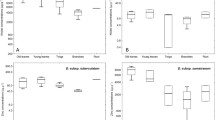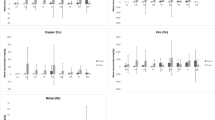Abstract
Field survey and greenhouse experiments were carried out to identify and characterize zinc (Zn) uptake and accumulation by a new Zn hyperaccumulating plant species (Sedum alfredii Hance) native to China. Zinc concentration in the shoots ofSedum alfredii Hance grown on an ancient mined area ranged from 4134 to 5000 mg/kg, with a mean of 4515 mg/kg. It suggests thatSedum alfredii could not only grow on heavily Pb/Zn contaminated soils, but also could accumulate extraordinarily high concentration of Zn. Under nutrient solution culture conditions,Sedum alfredii Hance grew healthy at Zn supplying levels from 0.006 to 240 mg · L−1. Zinc concentration in the shoots increased with external Zn levels increasing. The Zn concentration and accumulation in the shoots reached the highest at Zn supply level of 80 mg/L, with 19.67 g/kg and 19.83 mg/plant, respectively. All the results showed thatSedum alfredii Hance is a new Zn hyperaccumulating plant. This provides a new plant material to explore mechanism of plant to hyperaccumulate Zn, and a potent new plant species to phytoremediate Zn contaminated soils.
Similar content being viewed by others
References
Salt, D. E., Blaylock, M., Kumar, N. P. B. A. et al., Phytoremediation: A noval strategy for the removal of toxic metals from the environment using plants, Bio/Technology, 1995, 13: 468.
Conningham, S. D., Berti, W. R., Huang, J. W., Phytoremediation of contaminated soils, Bio/Technology, 1995, 13: 393.
Baker, A. J. M., Brooks, R. R., Terrestrial higher plants which hyperaccumulate metallic elememts, Biorecovery, 1989, 1: 81.
Reeves, R. D., Baker, J. M., Metal-accumulating plants, Phytoremediation of Toxic Metals: Using Plants to Clean Up the Environment (eds. Raskin, H., Ensley, B. D.), John Wiley & Sons, Ins, 2000, 193–230.
Brown, S. L., Chaney, R. L., Angle, J. S. et al., Zinc and cadmium uptake by hyperaccumulatorThlaspi caerulescens grown in nutrient solution, Soil Sci. Soc. Am. J., 1995, 59: 125.
Baker, A. J. M., Reeves, R. D., Hajar, A. S. M., Heavy metal accumulation and tolerance in British populations of the metallophyte Thlaspi caerulescens J. and C. Presl (Brassicaceae), New Phytol., 1994, 127: 61.
Brown, S. L., Chaney, R. L., Angle, J. S. et al., Phytoremediation potential ofThlaspi caerulescens and Bladder campion for zinc and cadmium-contaminated soil, J. Environ. Qual., 1994, 23: 1151.
Brown, S. L., Chaney, R. L., Angle, J. S. et al., Zinc and cadmium uptake by hyperaccumulatorThlaspi caerulescens and metal tolerantSilene vulgaris grown on sludge-amended soils, Environ. Sci. Technol., 1995, 29: 1581.
Robinson, B. H., Leblanc, M., Petit, D. et al., The potential ofThlaspi caerulescens for phytoremediation of contaminated soils, Plant and Soil, 1998, 203: 47.
Ebbs, S. D., Kochian, L. V., Toxicity of zinc to Brassica species: Implication for phytoremediation, J. Environ. Qual., 1997, 26: 776.
Ebbs, S. D., Kochian, L. V., Phytoextraction of zinc by oat (Avena sativa), barley (Hordeum vulgare), and Indian mustard (Brassica juncea), Environ. Sci. Technol., 1998, 32: 802.
Yang, X. E., Long, X. X., Ni, W. Z., Physiological and molecular mechanisms of heavy metal uptake by hyperaccumulating plants, Plant Nutrition and Fertilizer Science (in Chinese), 2002, 1: 8.
Wang, Q. R., Cui, Y. S., Dong, Y. T., Phytoremediation —An effective approach of heavy metal cleanup from contaminated soil, Acta Ecologica Sinica (in Chinese), 2001, 21(2): 326–331.
Yang, X. E., Shi, W. Y., Fu, Q. X. et al., Copper-hyperaccumulators of Chinese native plants: Characteristics and possible use for phyto-remediation. Sustainable Agriculture for Food, Energy and Industry (eds. Bassam, N. E. L.), London: James and James Publishers, 1998, 484–489.
Tang, S. R., Huang, C. Y., Zhu, Z. X.,Commelina communis L.: Copper hyperaccumulator found in Anhui Province of China, Pedosphere, 1997, 7(3): 207.
Chen, T. B., Wei, Z. Y., Huang, Z. C. et al., Arsenic hyperaccumulator —Pteris vittata L and its characteristic of accumulation of arsenic, Chinese Science Bulletin, 2002, 47(3): 207.
Long, X. X., Yang, X. E., Ye, Z. Q. et al., Study of the differences of uptake and accumulation of zinc in four species ofSedum linn, Acta Bot. Sin., 2002, 44(2): 152.
Yuan, D. W., Compared study on the pre-treatment methods for measuring soil total copper, zinc, lead, cadmium, nickel, and manganese, Agro-Environ. Protect Sinica (in Chinese), 1988, 7(1): 34.
Lindsay, W. L., Norvell, W. A., Development of a DTPA soil test for zinc, iron, manganese and copper, Soil Sci. Soc. Am. J., 1978, 42: 421.
Baker, J. M., McGrath, S. P., Reeves, R. D. et al., Metal hyperac-cumulatior plants: A review of the ecology and physiology resource for phytoremediation of metal-polluted soils, Phytoremediation of Contaminated Soil and Water (eds. Terry, N., Banuelos, G.), Boca Raton: Lewis Publishers, 2000, 85–100.
Author information
Authors and Affiliations
About this article
Cite this article
Yang, X., Long, X., Ni, W. et al. Sedum alfredii H: A new Zn hyperaccumulating plant first found in China. Chin.Sci.Bull. 47, 1634–1637 (2002). https://doi.org/10.1007/BF03184113
Received:
Issue Date:
DOI: https://doi.org/10.1007/BF03184113




